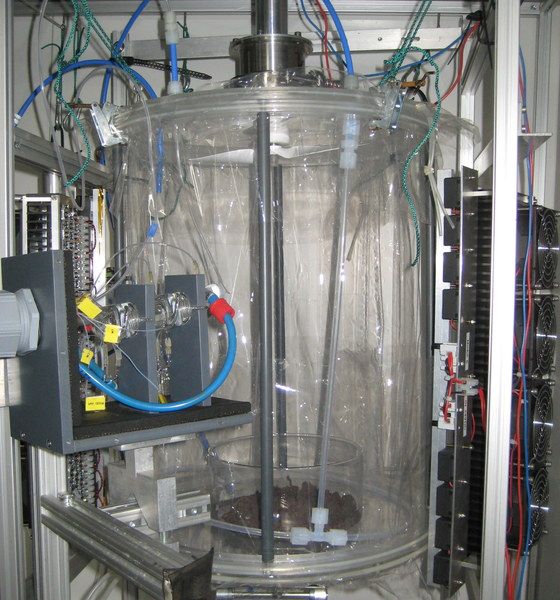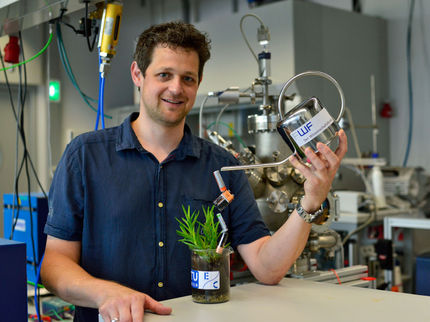Nitrogen in the soil cleans the air
Nitrogen-containing soil is a source of hydroxyl radicals that remove pollutants from the atmosphere
Eutrophication harms the environment in many ways. Unexpectedly, nitrogen fertilizer may also be positive for the environment. And even acidic soils, promoting the destruction of forests, can have a positive effect. Researchers from the Biogeochemistry Department at the Max Planck Institute for Chemistry in Mainz found out that nitrogen fertilizer indirectly strengthens the self-cleaning capacity of the atmosphere. Their study shows that nitrous acid is formed in fertilized soil and released to the atmosphere, whereby the amount increases with increasing soil acidity. In the air, nitrous acid leads to the formation of hydroxyl radicals oxidizing pollutants that then can be washed out. Previously, this nitrogen-effect has not been taken into account by geoscientists. The gap has now been closed by the Max Planck researchers.

What is the source of nitrous acid in the atmosphere? Mainz scientists study the exchange of gases between soil samples and the air in this reaction chamber.
© Su, Max Planck Institute for Chemistry
Our air partly cleans itself as pollutants are being oxidized by hydroxyl radicals and washed out by rain. Now, researchers at the Max Planck Institute in Mainz and colleagues in Beijing have discovered the origin of a bulk part of the nitrous acid that is acting beside ozone as a source of hydroxyl radicals. According to their studies, large quantities of the acid are released into the atmosphere from soil. In nitrogen-rich soils the acid is formed from nitrite ions produced through microbiological transformations of ammonium and nitrate ions. The more acidic the soil is and the more nitrite it contains, the more nitrous acid is released. Through this pathway some of the nitrogen in fertilized soil escapes into the air.
In the latest issue of the journal Science, the Mainz researchers describe how they demonstrated the existence of this previously unnoticed pathway in the nitrogen cycle. They measured the concentration of HONO – a chemical term for gaseous nitrous acid – that escaped from a defined volume of arable soil. They added nitrite to a soil sample and varied its water content. The quantity of released HONO closely matched the researchers' estimates based on acid/base and solubility equilibria. Based on these findings they can also explain why previous studies had measured high levels of HONO in the air above fertilized agricultural soil.
In the future, soil-based HONO emissions may even increase on a world-wide basis
The source of the high concentrations of HONO observed in the lower atmosphere had long been a mystery. "Soil is a complex system involving interactions between countless chemicals and biological organisms,” says Hang Su, the lead author of the paper. “Before us, no one seems to have investigated the soil-atmosphere exchange of nitrous acid".
The fact that soil emits HONO is not just locally, but also globally significant for air quality and the nitrogen cycle. "Next, we plan to work across disciplines with soil and climate researchers to quantify the effect in different types of soil and under different environmental conditions", adds research group leader Ulrich Pöschl. The findings will then be incorporated into a global model.
The Max Planck researchers suspect that soil-based HONO emissions could strongly increase especially in developing countries due to more extensive fertilization, soil acidification, and climate-related rise in temperature. This is expected to produce more hydroxyl radicals, which increase the oxidizing power of the air.
Original publication
Other news from the department science

Get the chemical industry in your inbox
By submitting this form you agree that LUMITOS AG will send you the newsletter(s) selected above by email. Your data will not be passed on to third parties. Your data will be stored and processed in accordance with our data protection regulations. LUMITOS may contact you by email for the purpose of advertising or market and opinion surveys. You can revoke your consent at any time without giving reasons to LUMITOS AG, Ernst-Augustin-Str. 2, 12489 Berlin, Germany or by e-mail at revoke@lumitos.com with effect for the future. In addition, each email contains a link to unsubscribe from the corresponding newsletter.




























































